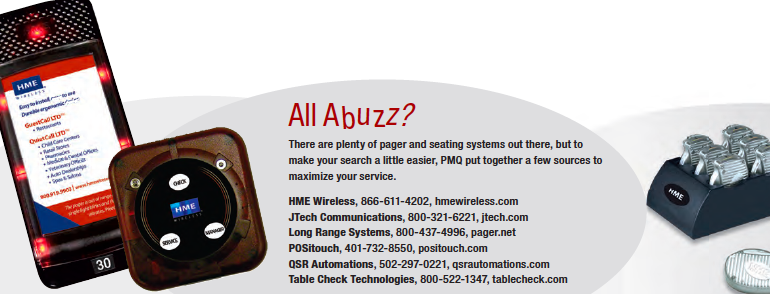 When tightening your pizzeria’s operations, communication is key—but that doesn’t always mean word of mouth. If you’re looking to speed up your hosts and servers, or simply keep better track of your customers on busy nights, adopting a pager system that fi ts your business model may reduce lag time, as well as increase customer satisfaction and, most importantly, profits. Consider the two major types of pager systems when planning to use this technology: customer pagers and pagers for your staff. “Server paging lets your wait-staff know when food is ready, while guest paging is for waiting on tables and, in some places, calling guests to the counter when their order is ready,” says Russ Ford, vice president of pager manufacturer HME Wireless in Suwanee, Georgia. “Some restaurants even use two-way radios to keep managers and staff in close communication. However, all systems should guarantee hot food every time.”
When tightening your pizzeria’s operations, communication is key—but that doesn’t always mean word of mouth. If you’re looking to speed up your hosts and servers, or simply keep better track of your customers on busy nights, adopting a pager system that fi ts your business model may reduce lag time, as well as increase customer satisfaction and, most importantly, profits. Consider the two major types of pager systems when planning to use this technology: customer pagers and pagers for your staff. “Server paging lets your wait-staff know when food is ready, while guest paging is for waiting on tables and, in some places, calling guests to the counter when their order is ready,” says Russ Ford, vice president of pager manufacturer HME Wireless in Suwanee, Georgia. “Some restaurants even use two-way radios to keep managers and staff in close communication. However, all systems should guarantee hot food every time.”
Business Smarts
When figuring out what is right for you, the assessment process should be simple. Your equipment should take your existing business model—whether it’s fast-casual, casual or high-end dining—and make it more enjoyable for your customers. For instance, The Loop Pizza Grill (looppizzagrill.com), a 14-unit fast-casual chain with locations in Florida, Georgia and North Carolina, doesn’t use servers, but a few years ago, calling out ready orders over a PA system started to ruin the restaurant’s vibe, according to Chris Hartley, director of operations for the chain. “For us, pagers are a more assured way to communicate with our customers,” he says. “When guests have to wait and listen for a name, it can create a certain amount of uneasiness out of fear they might hear incorrectly. So while this technology hasn’t necessarily increased the speed of our service, it has increased accuracy and minimizes intrusion of the guest experience.”
However, if you operate a traditional dine-in operation, with hosts, waiters, and guests who wait at the bar or outside for a table, a lot of jobs are going on at one time. Pagers can keep employees working together to best serve customers. “The obvious advantage to pizzerias is speed,” notes Jim Livingston, vice president of sales for Long Range Systems in Addison, Texas. “When your servers and hosts don’t have to waste time trying to find guests, you ultimately speed up service and increase profits. I’ve seen large restaurants where one-hour wait times turn into 45 minutes.” But you needn’t run a large-scale operation to seek better seating solutions—after all, the less seats you have, the longer your customers’ potential waiting time, especially if you’re well-established.
Meanwhile, staff pagers are a great way for managers to stay in communication with their employees. With either an alphanumeric pager or a vibrating pager, simple messages can reduce time trying to track down staff. While an alphanumeric pager can send a digital message, vibrating pagers can also allow hosts and managers to let servers know what’s happening in their sections. Livingston notes that most managers use a “1-2-3” system for paging staff members: One vibration means you’re needed at the front, two vibrations means you have a phone call, and three vibrations means a table in your section has been seated. But, of course, the actual meanings you create for your operation are up to you.
A final consideration: While pager theft is not likely to drive your pizzeria into financial ruin, occasional lost pagers are a reality, especially when you’re handing them out on a busy night. Ultimately, factor the number of pagers you have in use with the night’s wait length. Livingston notes that if you have 100 pagers in use, you’re likely to lose one per month to theft or damage. But the possibility of theft greatly rises when wait times exceed one hour. So if you’re a high-volume operation with long waits, you might ask customers to check in later for a pager to avoid loss or damage. Also, ask your vendor if his pagers are equipped with any anti-theft technology such as tracking devices; the range on these can often be adjusted by the host, who can then inform the guest how far he can go and keep his spot in line; the closer you keep guests to the location, the faster the service.

New Technology
While it may seem like pagers have been around forever, more options than the traditional vibrating and flashing black boxes are now available. And, though not everyone who comes into your shop will have a cell phone, in the last fi ve years, more systems have been developed that work with both your in-house pagers and customers’ phones. This reduces theft, can help you acquire numbers for text message marketing and—as noted by Livingston—automatically decreases the number of pagers you will need to buy (and ultimately replace) by as much as 50%.
However, Ford notes another emerging technology in food delivery: Newly developed “locator pagers” are traditional-looking pagers that help keep track of customers. They allow guests to order at the counter, then choose any seat in the house without having to take a number. “When customers place the pager on the table, it syncs up and tells the kitchen exactly where they’re seated,” he explains. “The unique thing about this technology is that, unlike systems where you have to have a large bulky device on the table or the guests have to activate the table for the system to work, the guest simply places the pager anywhere on the table to automatically update the kitchen.”
Make sure to communicate with your POS provider when planning to utilize new pager solutions, as not all programs work with one another. Your software may affect the way staff members use your system and which functions your POS can perform with pagers. “Features such as graphical floor plans can provide updates and status icons for events such as table seated, order rushes and check received,” says Heather Pitts, marketing coordinator at POS provider QSR Automations in Louisville, Kentucky. “This means that a pizzeria manager can view up-to-the-minute statuses of every table on the intuitive floor plan, ensuring that every team member has the information needed at all times. A pizzeria that is regularly on a wait may also manage seating suggestions and wait time quotes differently during lunch.”
Whether you’re a mom-and-pop shop or a growing chain, the decision to upgrade your current seating and organization solutions to pager usage for customers and/or staff is one that can bring in a big return over time, especially if you’re known for having busy nights. But first make sure you communicate with your POS provider to make sure you get the best technology for your current setup. And, of course, newer technologies have been developed to reduce theft and save you on replacement costs. Ultimately, however, the advantages come down to increased accuracy and speed—for customers and waitstaff. In those two areas, most operators agree, there’s always room for improvement.














